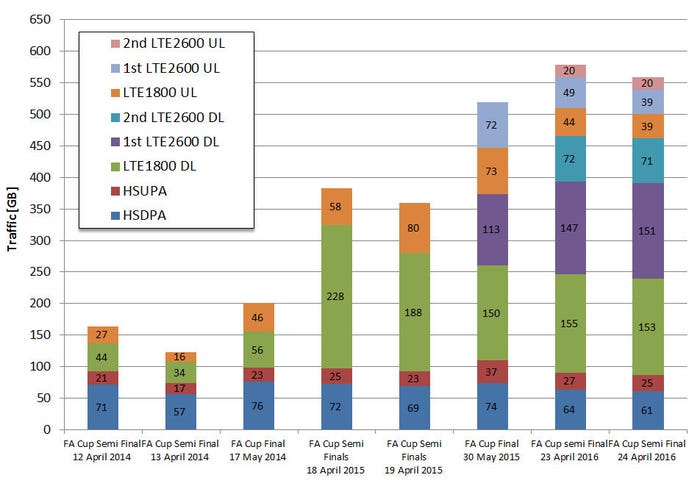EE reveals Wembley Stadium FA Cup mobile data consumptionEE reveals Wembley Stadium FA Cup mobile data consumption
UK operator EE has shared the details of mobile data consumption over its network during FA Cup games at Wembley and says consumption has tripled in just two years.
May 20, 2016

UK operator EE has shared the details of mobile data consumption over its network during FA Cup games at Wembley and says consumption has tripled in just two years.
Back in the 2014 FA Cup semi-finals 3G – mainly HSDPA (downlink) – still accounted for more data than 4G. By the final a month later, however, the tide had turned and LTE accounted for the majority of mobile data use, with uplink (UL) especially high during an action-packed match that the crowd clearly felt compelled to share liberally with the outside world.
2014-15 was a phase of exponential growth in EE 4G adoption and by the 2015 semi-finals stadium mobile data use had nearly tripled, driven almost entirely by 4G users. Then, before the final, EE introduced its first 2600 MHz carrier to supplement the 1800 MHz band. This was primarily a capacity play as phones don’t yet support carrier aggregation the new carrier immediately accounted for almost half of the 4G traffic.
2016 saw the introduction of a second 2600 MHz carrier by EE, adding the full amount of that band acquired in the 2013 auction to the existing 1800 MHz carrier, giving EE 55 MHz of LTE spectrum in total. Consumption has shot up once more and is set to top 600 GB at this weekend’s final, more than three times the amount of the 2014 final. EE told Telecoms.com that it still has spare capacity, so it looks like there increases are mainly driven by demand, rather than supply.
“Video is the most challenging application in any environment, but particularly in an extremely densely populated venue like Wembley,” said EE’s Head of Video and Content Strategy, Matt Stagg. “We’ve built enough capacity – at both airside and in the backhaul – to be able to meet the fans’ demands, and we’ll keep innovating and investing to make sure we stay ahead of that demand.”
As part of its stadium sponsorship deal, which began in February 2014, EE built an LTE Distributed Antenna System (DAS). The stadium is split into 24 sectors, with each antenna optimised to reach the section of the crowd it covers. There are four covering the pitch itself, for events like music and boxing. Vodafone also uses the EE-built DAS with 30 MHz of spectrum but O2 and Three use the old 3G system and service coming in from towers outside the stadium.
Here’s the full data from EE, including this year’s semi-finals.

About the Author
You May Also Like










.png?width=300&auto=webp&quality=80&disable=upscale)


_1.jpg?width=300&auto=webp&quality=80&disable=upscale)